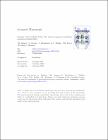| dc.contributor.author | BALSTERS, JOSHUA | en |
| dc.date.accessioned | 2009-10-28T12:43:20Z | |
| dc.date.available | 2009-10-28T12:43:20Z | |
| dc.date.issued | 2009 | en |
| dc.date.submitted | 2009 | en |
| dc.identifier.citation | Balsters, J.H., Cussans, E., Diedrichsen, J., Phillips, K., Preuss, T.M., Rilling, J.K., & Ramnani, N, Evolution of the Cerebellar Cortex: Selective expansion of prefrontal-projecting lobules, NeuroImage, 49, 3, 2009, 2045-2052 | en |
| dc.identifier.other | Y | en |
| dc.identifier.uri | http://hdl.handle.net/2262/34366 | |
| dc.description | PUBLISHED | en |
| dc.description.abstract | It has been suggested that interconnected brain areas evolve in tandem because evolutionary pressures act on complete functional systems rather than individual brain areas. The cerebellar cortex has reciprocal connections with both the prefrontal cortex and motor cortex, forming independent loops with each. Specifically, in capuchin monkeys cerebellar cortical lobules CrusI and CrusII connect with prefrontal cortex, whereas the primary motor cortex connects with cerebellar lobules V,VI,VIIb, and VIIIa. Comparisons of extant primate species suggest that the prefrontal cortex has expanded more than cortical motor areas in human evolution. Given the enlargement of the prefrontal cortex relative to motor cortex in humans, our hypothesis would predict corresponding volumetric increases in the parts of the cerebellum connected to the prefrontal cortex, relative to cerebellar lobules connected to the motor cortex. We tested the hypothesis by comparing the volumes of cerebellar lobules in structural MRI scans in capuchins, chimpanzees and humans. The fractions of cerebellar volume occupied by CrusI and CrusII were significantly larger in humans compared to chimpanzees and capuchins. Our results therefore support the hypothesis that in the cortico-cerebellar system, functionally related structures evolve in concert with each other. The evolutionary expansion of these prefrontal-projecting cerebellar territories might contribute to the evolution of the higher cognitive functions of humans. | en |
| dc.description.sponsorship | This study was supported by grants from the BBSRC (No. 1590-1573 to NR), the National
Science Foundation (BSC 0726685, to JD), the Yerkes base grant (NIH RR00165 to TP) and
the James S. McDonnell Foundation Grant (JSMF 21002093 to TP). JHB was supported by
RHUL-SGUL joint scholarship awarded to NR; EC was supported by Wellcome Trust
Vacation Scholarship to NR and EC; NR was supported by a grant from the BBSRC (UK). | en |
| dc.format.extent | 2045-2052 | en |
| dc.format.mimetype | application/pdf | |
| dc.language.iso | en | en |
| dc.relation.ispartofseries | NeuroImage | en |
| dc.relation.ispartofseries | 49 | en |
| dc.relation.ispartofseries | 3 | en |
| dc.rights | Y | en |
| dc.subject | Administrative Staff Authors | en |
| dc.title | Evolution of the Cerebellar Cortex: Selective expansion of prefrontal-projecting lobules | en |
| dc.type | Journal Article | en |
| dc.type.supercollection | scholarly_publications | en |
| dc.type.supercollection | refereed_publications | en |
| dc.identifier.peoplefinderurl | http://people.tcd.ie/balsterj | en |
| dc.identifier.rssinternalid | 53898 | en |
| dc.identifier.rssuri | http://dx.doi.org/10.1016/j.neuroimage.2009.10.045 | |
| dc.contributor.sponsor | Wellcome Trust | |




